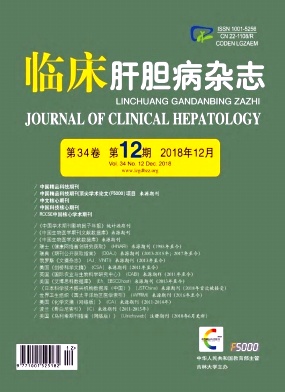|
[1] SAPISOCHIN G, CASTELLS L, DOPAZO C, et al. Single HCC in cirrhotic patients:Liver resection or liver transplantation? Long-term outcome according to an intention-to-treat basis[J]. Ann Surg Oncol, 2013, 20 (4) :1194-1202.
|
|
[2] WU HL, ZHENG SJ, DUAN ZP. Route of metastasis of primary hepatic carcinoma from the perspective of anatomy[J]. J Clin Hepatol, 2017, 33 (10) :2009-2015. (in Chinese) 伍慧丽, 郑素军, 段钟平.从解剖学角度探讨原发性肝癌的转移途径[J].临床肝胆病杂志. 2017, 33 (10) :2009-2015.
|
|
[3] CHOI JY, LEE JM, SIRLIN CB. CT and MR imaging diagnosis and staging of hepatocellular carcinoma:part I. Development, growth, and spread:Key pathologic and imaging aspects[J]. Radiology, 2014, 272 (3) :635-654.
|
|
[4] RODRIGUEZ-PERALVAREZ M, LUONG TV, ANDREANA L, et al. A systematic review of microvascular invasion in hepatocellular carcinoma:Diagnostic and prognostic variability[J]. Ann Surg Oncol, 2013, 20 (1) :325-339.
|
|
[5] QI YP, ZHONG JH, LIANG ZY, et al. Adjuvant transarterial chemoembolization for patients with hepatocellular carcinoma involving microvascular invasion[J]. Am J Surg, 2018.[Epub ahead of print]
|
|
[6] YE JZ, CHEN JZ, LI ZH, et al. Efficacy of postoperative adjuvant transcatheter arterial chemoembolization in hepatocellular carcinoma patients with microvascular invasion[J]. World J Gastroenterol, 2017, 23 (41) :7415-7424.
|
|
[7] ADLER M, LAROCCA L, TROVATO FM, et al. Evaluating the risk of hepatocellular carcinoma in patients with prominently elevated liver stiffness measurements by Fibro Scan:A multicentre study[J]. HPB (Oxford) , 2016, 18 (8) :678-683.
|
|
[8] LI JW, LING WW, LU Q, et al. Liver stiffness and serum alphafetoprotein in discriminating small hepatocellular carcinoma from cirrhotic nodule[J]. Ultrasound Q, 2016, 32 (4) :319-326.
|
|
[9] BAILLY M, VENEL Y, ORAIN I, et al. 18F-FDG PET in liver transplantation setting of hepatocellular carcinoma:Predicting histology?[J]. Clin Nucl Med, 2016, 41 (3) :e126-e129.
|
|
[10] YANG C, WANG H, SHENG R, et al. Microvascular invasion in hepatocellular carcinoma:Is it predictable with a new, preoperative application of diffusion-weighted imaging?[J]. Clin Imaging, 2017, 41:101-105.
|
|
[11] UNAL E, IDILMAN IS, AKATA D, et al. Microvascular invasion in hepatocellular carcinoma[J]. Diagn Interv Radiol, 2016, 22 (2) :125-132.
|
|
[12] SUH YJ, KIM MJ, CHOI JY, et al. Preoperative prediction of the microvascular invasion of hepatocellular carcinoma with diffusionweighted imaging[J]. Liver Transpl, 2012, 18 (10) :1171-1178.
|
|
[13] XU P, ZENG M, LIU K, et al. Microvascular invasion in small hepatocellular carcinoma:Is it predictable with preoperative diffusion-weighted imaging?[J]. J Gastroenterol Hepatol, 2014, 29 (2) :330-336.
|
|
[14] ZHAO J, LI X, ZHANG K, et al. Prediction of microvascular invasion of hepatocellular carcinoma with preoperative diffusion-weighted imaging:A comparison of mean and minimum apparent diffusion coefficient values[J]. Medicine (Baltimore) , 2017, 96 (33) :e7754.
|
|
[15] LEE S, KIM SH, HWANG JA, et al. Pre-operative ADC predicts early recurrence of HCC after curative resection[J]. Eur Radiol, 2018.[Epub ahead of print]
|
|
[16] LI H, ZHANG J, ZHENG Z, et al. Preoperative histogram analysis of intravoxel incoherent motion (IVIM) for predicting microvascular invasion in patients with single hepatocellular carcinoma[J]. Eur J Radiol, 2018, 105:65-71.
|
|
[17] WOO S, LEE JM, YOON JH, et al. Intravoxel incoherent motion diffusion-weighted MR imaging of hepatocellular carcinoma:Correlation with enhancement degree and histologic grade[J]. Radiology, 2014, 270 (3) :758-767.
|
|
[18] ZHAO W, LIU W, LIU H, et al. Preoperative prediction of microvascular invasion of hepatocellular carcinoma with IVIM diffusionweighted MR imaging and Gd-EOB-DTPA-enhanced MR imaging[J]. PLo S One, 2018, 13 (5) :e0197488.
|
|
[19] ROSENKRANTZ AB, SIGMUND EE, WINNICK A, et al. Assessment of hepatocellular carcinoma using apparent diffusion coefficient and diffusion kurtosis indices:Preliminary experience in fresh liver explants[J]. Magn Reson Imaging, 2012, 30 (10) :1534-1540.
|
|
[20] WANG WT, YANG L, YANG ZX, et al. Assessment of microvascular invasion of hepatocellular carcinoma with diffusion kurtosis imaging[J].Radiology, 2018, 286 (2) :571-580.
|
|
[21] WU TH, HATANO E, YAMANAKA K, et al. A non-smooth tumor margin on preoperative imaging predicts microvascular invasion of hepatocellular carcinoma[J]. Surg Today, 2016, 46 (11) :1275-1281.
|
|
[22] SHIRABE K, KAJIYAMA K, ABE T, et al. Predictors of microscopic portal vein invasion by hepatocellular carcinoma:Measurement of portal perfusion defect area ratio[J]. J Gastroenterol Hepatol, 2009, 24 (8) :1431-1436.
|
|
[23] AHN SY, LEE JM, JOO I, et al. Prediction of microvascular invasion of hepatocellular carcinoma using gadoxetic acid-enhanced MR and (18) F-FDG PET/CT[J]. Abdom Imaging, 2015, 40 (4) :843-851.
|
|
[24] SUN Y, ZHANG N, HOU J, et al. Value of Gd-EOB-DTPAenhanced MRI in diagnosis of hepatocellular carcinoma[J]. J Clin Hepatol, 2018, 34 (1) :129-132. (in Chinese) 孙玉, 张楠, 侯洁, 等.钆塞酸二钠MRI对肝细胞癌的诊断价值[J].临床肝胆病杂志, 2018, 34 (1) :129-132.
|
|
[25] KIM KA, KIM MJ, JEON HM, et al. Prediction of microvascular invasion of hepatocellular carcinoma:usefulness of peritumoral hypointensity seen on gadoxetate disodium-enhanced hepatobiliary phase images[J]. J Magn Reson Imaging, 2012, 35 (3) :629-634.
|
|
[26] NISHIE A, ASAYAMA Y, ISHIGAMI K, et al. Clinicopathological significance of the peritumoral decreased uptake area of gadolinium ethoxybenzyl diethylenetriamine pentaacetic acid in hepatocellular carcinoma[J]. J Gastroenterol Hepatol, 2014, 29 (3) :561-567.
|
|
[27] SHIN SK, KIM YS, SHIM YS, et al. Peritumoral decreased uptake area of gadoxetic acid enhanced magnetic resonance imaging and tumor recurrence after surgical resection in hepatocellular carcinoma:A STROBE-compliant article[J]. Medicine (Baltimore) , 2017, 96 (33) :e7761.
|
|
[28] MIN JH, KIM YK, LIM S, et al. Prediction of microvascular invasion of hepatocellular carcinomas with gadoxetic acid-enhanced MR imaging:Impact of intra-tumoral fat detected on chemicalshift images[J]. Eur J Radiol, 2015, 84 (6) :1036-1043.
|
|
[29] KIM MJ, LEE M, CHOI JY, et al. Imaging features of small hepatocellular carcinomas with microvascular invasion on gadoxetic acid-enhanced MR imaging[J]. Eur J Radiol, 2012, 81 (10) :2507-2512.
|







 DownLoad:
DownLoad: